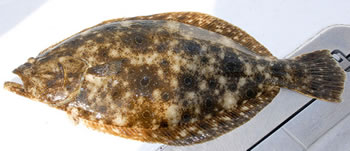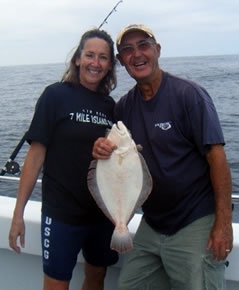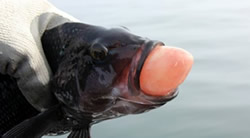By Matthew Heyl, Hourly Biologist
Studies from the New York and Virginia Sea Grant program sampled 461 summer flounder by hook and line. The study used sproat hooks (type of J hook), wide gap hooks, and circle hooks to follow fish that were hooked properly and fish that where hooked internally. The summer flounder that were hooked properly had an average mortality rate of 7.5% between the three hooks. The hooks had similar rates of fish mortality. When hooked internally the sproat hook lead to a fish mortality of 80%, wide gap hook mortality was 60%, and circle hook mortality was 56.5%. Interesting to note is that most fluke caught in this hook and line study where caught using circle hooks. Fluke are aggressive predatory fish and will consume many different species of fish and crustaceans as well as artificial offerings. When fishing with a big bait, use a bigger hook. For example, fishing a peanut bunker or snapper bluefish with the same hook that an angler would use for a clam or squid strip is only encouraging a summer flounder to become gut hooked. If fishing with a smaller bait like a silverside or mummichog try fishing a circle hook to decrease short fish mortality. Regardless of the style of hook used, fishing with barbless hooks, or hooks where the barb is crimped, makes releasing a short fish easier and faster. It does require keeping a taut line to not lose a fish, but fish can sometimes be released simply by letting the line go slack, ensuring the fish is unharmed to be caught again.
APPROACHES and RELEASE METHODS
The most exciting part of summer flounder fishing is anticipating and receiving that first "hit" of the day. An approach to make sure the angler feels that hit is as simple as being in contact with the fishing pole. With advances in sensitivity technology with fishing line types like monofilament and braid, an angler with a finger on line can feel every bump, crevasse, or fish hit while fishing. All too often anglers leave a fishing rod in the water unattended. This is known as dead-sticking. As soon as the angler walks away a fish will hit and without an angler to set the hook, the fish will swallow the hook, and become gut hooked, leading to increased fish mortality. If you must leave or take a break, ask a friend to "watch the rod" or just simply just reel up. After feeling that hit and catching a short summer flounder what should you do next? The simple answer is return the fish to the water as soon as possible, but there is much more the angler can do to decrease fish mortality. Summer flounders have a slimy layer that is a frontline protection from bacteria. A break in a fish's slime is like a cut on a human's skin. The best way to protect the fish is the "less is more" method. The less the fish is touched the more of a chance the fish will survive. At the water surface the fish should be netted, then if not being kept a rag dipped in salt water should be used to hold the fish and a pair of pliers used to release the hook from the fish. If the fish is gut hooked it is recommended that the line be cut as close to the hook as possible. Fish mortality is greater if an angler attempts to "rip" a hook out of the fish damaging the important gills. A hook that's cut off will eventually rust and will reduce fish mortality. A summer flounder should never touch a deck, jetty, beach, bulkhead, sod bank, or pavement unless the fish is going to be dinner. FISH for the FUTURE Ethical angling goes beyond summer flounder fishing. All New Jersey's marine fish can benefit from proper release methods. Decide on what species of fish you will be targeting and know the minimum size before fishing. Mates on party and charter boats will have a wealth of knowledge in regards to minimum size, but if fishing from the shore or jetty download the New Jersey Fish and Wildlife App for updated minimum lengths. Also, at many of the inlets throughout the state there are signs that have the up-to-date minimum fish lengths. Tackle that is heavy enough to reel a fish in quickly is beneficial to the fish. An exhausted fish can lead to increased fish mortality. One of the best parts of fishing is fighting the fish, with the thrill of landing it. Many fish are never landed. Anglers that do not use the correct line, terminal tackle, and rod are guaranteed to lose more fish than they catch. Always know your fish. An angler would not want to use an ultra-lite rod while targeting 40-pound striped bass. Anglers that have questions or are not sure on which tackle to use should visit one of the many tackle shops around the state. While preparing for that big hit when soaking a clam or casting a popper plug there are techniques to decrease fish mortality of a hooked fish. If bait fishing use a circle hook, but step it up a notch and try a non-offset circle hook. If using a popping plug for bluefish, try reducing the number of hooks on the plug. Most plugs will come with three treble hooks. Try reducing the number of treble hooks to just one or replace all three treble hooks with one J hook. The bluefish will not know the difference and neither will the angler. The three treble hooks tend to get in the way when the angler lands the fish and the hooks always find their way into either the fish or the angler's hand. When using a J hook as part of a jig head when trying to land that tide runner weakfish, cut off the barb. It will make releasing the fish a lot easier. When a fish swallows the hook, and it will happen if a person fishes enough, cut the line as close to the hook as possible and use non-stainless steel hooks that will rust over time. Dehooking, handling, and reviving fish properly can make the difference between life and death for the fish. Having dehooking tools like pliers or a multi-tool can be beneficial for a quick return into the water. A pair of pliers in a surf bag or bucket in an easy to reach location can quickly return a striper or sea robin to the surf. Pliers in a sheath that attach to a belt allows anglers to help mates out on a boat when the fish start hitting with a fury. Pliers and multi-tools can range in price from a few dollars to several hundred dollars. When handling that big catch use a wet towel or at least wet hands to protect the fish's slime coat. If taking a picture with the fish, hold it horizontally with both hands underneath it to support the fish's weight to decrease the chance of internal damage. Avoid holding the fish by the gills, eyes, and tail. Use a plastic holding device that grips the lips.
TRY IT YOURSELF This summer, while fishing for summer flounder or any fish species, stop by your local tackle shop and pick up more fish-friendly products. Try using different hooks and sizes and record your fishing trips. Write down what fishing outfit was used, terminal tackle, bait, size of the fish, whether the fish was kept or released, if the fish swallowed the hook, fish health when released, and any other information that would be useful to you. Take the challenge and you might be surprised that new fish-friendly products might out fish the older products. Regardless of your success or lack of success, fill out a trip report for the voluntary Recreational Angler Survey on the Division's website. Your input is important to fisheries management. SOURCES Atlantic States Marine Fisheries Commission. Washington, D.C.: Atlantic States Marine Fisheries Commission, 2003. Circle Hook Definition and Research Issues. Web. www.monmouth.edu/uploadedFiles/Resources/Urban_Coast_Institute/CircleHookDefinitionReport.pdf. Fishing Lines An Angler's Guide to Florida's Marine Resources. N.p.: Florida Fish and Wildlife, n.d. Print. Malchoff, Mark H., and Jon A. Lucy. Short Term Hooking Mortality of Summer Flounder in New York and Virginia. Tech. N.p.: n.p., 1998. Print. Halgren, Bruce. NJDEP Division of Fish & Wildlife - Fluke Fishing and Companionship. July, 1998. www.njfishandwildlife.com/flukefsh.htm. Halgren, Bruce. NJDEP Division of Fish & Wildlife - Fluke: Facts and Fishing. August, 2004. www.njfishandwildlife.com/flukefct.htm. Salierno, James, and Carl Benson. Optimization of Hook Size in the N.J. Summer Flounder, Paralichthys Dentatus, Hook and Line Fishery. Rep. Fairleigh Dickinson University/ New Jersey Resident Commercial Hook and Line Fishermen, n.d. Web. 7 June 2017. https://static1.squarespace.com/static/511cdc7fe4b00307a2628ac6/t/5535426de4b0fc1dd6800f5f/1429553773399/09_SF+Bycatch+Combined.pdf. The Difference Between Circle and "J" Hooks. Florida Fish and Wildlife Conservation Commission, n.d. http://myfwc.com/research/saltwater/fish/other/circle-j-hooks/. |
|||||||||||||||
|
||
|
|
||
|
||
| |
||






